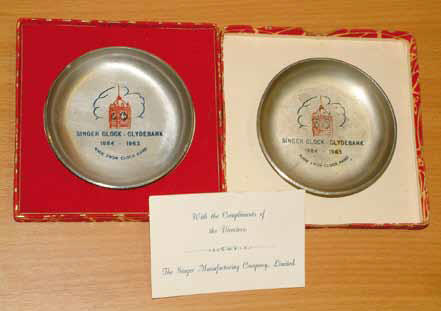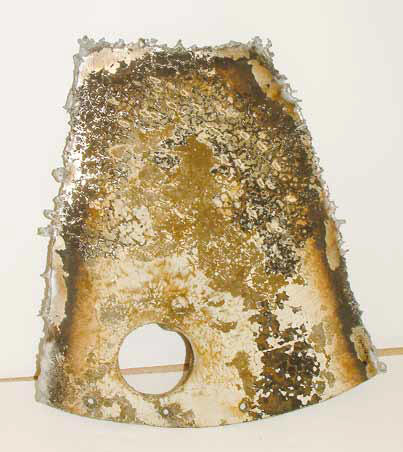All hands to the ashtrays!
ISMACS News 106
March 2012

A long time ago (ISMACS News, #46), Graham Forsdyke reported on the final minutes of the Singer clock at Clydebank; how the huge hands – there were eight – had been later, heaven forfend, recycled into ashtrays and the internal workings had gone 'missing'.
For whatever reason, some dispute arose over the ashtrays story and, as neither parties had ever seen one, anecdotal evidence was all there was.
Just to put the record straight, your Chairman was bang on the money, as these two examples show. Each came in a gay presentation box with a card from the Singer directors.
I bet they saved a fortune on corporate gifts that Christmas.
The ashtrays surely weren't something that lowly workers might have received. You could get sacked for making a cup of tea there in the bad old days, never mind taking a smoke break.
So that was the fate of at least some of the hands.

The last surviving piece of Singer's Clydebank clock?
There is one remaining piece of an hour hand, given to Clydebank's museum by a well-meaning passer-by who spotted it being thrown in a dumpster. Given the significance of Singer to the local community – it employed half the large town – I would imagine at least a small crowd would have witnessed the demolition of a major landmark.
Perhaps more pieces exist - and who knows what flat lumps of aluminium were sold as 'Singer hands' around the pubs of Glasgow? Provenance is seldom an issue after three pints of 'heavy'.
The whereabouts of the clock workings is still mysterious. The county Museums and Libraries department has never had it but the search continues. In fact, one of its staff recently freeze-framed his way through the movie "Gregory's Girl", filmed in Cumbernauld, because reports suggested the clock had been re-deployed in their new shopping centre.
Where would we be without rigorous academic research, eh? JL
Editor's note: Sadly, we are confident the clock no longer exists. The original mechanical turret clock of 1883 was scrapped c.1930 and replaced by a Gents 'waiting train' electric impulse mechanism. So, from then onwards, there was no clock in the tower and tales of it crashing down during demolition are a myth. The master Gents, a small box, would have been in the company time-keeper's office as it also registered when employees clocked in and out. Each of the clock faces received an actuator feed, with halfminute impulses. MG





